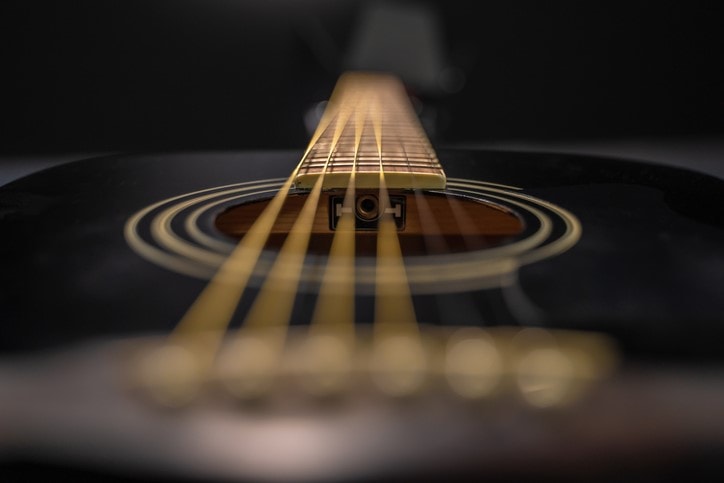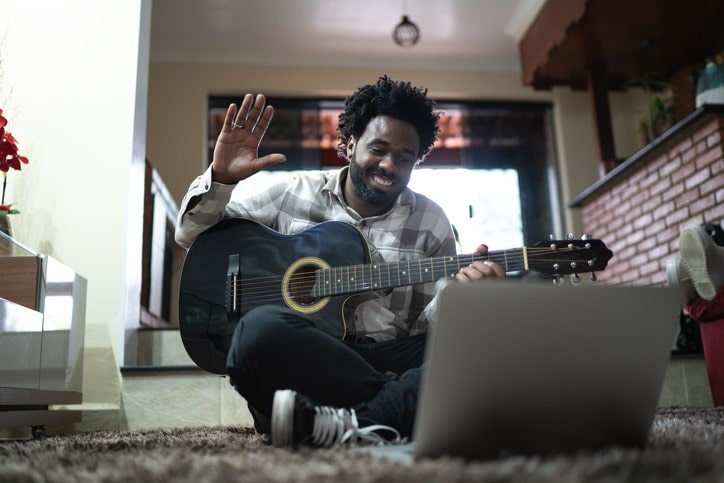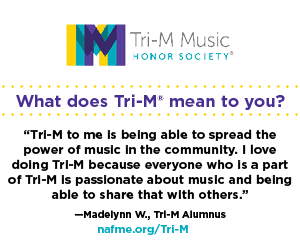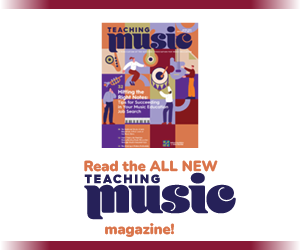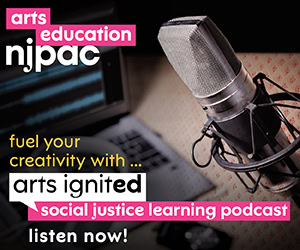/ News Posts / Classroom Learning vs. Distance Learning in the Music Classroom
Classroom Learning vs. Distance Learning in the Music Classroom
Seven Benefits of Distance Learning to Consider
By Darin Au
NAfME Council for Guitar Education Western Division Representative
Ah, distance learning. I miss having a guitar in my hand versus having my hands on a computer keyboard. Some things were just easier when we were learning together in the classroom. It was easier to build community. Everything I did, from activities to tone of voice to just simply laughing, created a culture of learning. My students are probably like yours: They miss ensemble playing. They miss being together, making music together, and are probably tired of submitting videos for class. This is because feedback is immediate in the classroom, and it goes both ways. I give feedback to students, and they give me feedback, which dictates what we do minute to minute. In school, we’re also given a discrete period of time to engage in music together. We know, for that class period, we are able to work toward a common goal and help each other. I also miss my relatively low-tech classroom because as a guitarist, I’ve always said, “All I need is the wood and six strings to teach my students.”
A few weeks ago, I had to prepare for our annual Open House for parents. This year, I decided to talk to parents about the positives of being in the classroom and the positives of distance learning. I chose this for two reasons. 1) Our school has plans for distance, hybrid, and in-person learning this year which we will deploy depending on the course of the pandemic. 2) Comments about distance learning from teachers and parents have trended toward the negative, but learning from home has some positives! After teaching in a distance learning environment the past six months, including a non-music class in summer school, I’ve come up with a list of things I’ve found are better in distance learning than in classroom learning.
There are certain advantages to distance learning so long as students have the technological infrastructure and, for non-singers, an instrument at home. I acknowledge I am fortunate my students all have instruments, and when a family is unable to acquire one, I am able to assist. I am also fortunate our school provides students with a laptop and nearly every student has adequate internet access. When they don’t, the school provides a hotspot for the student to take home. I know many students and teachers across the United States aren’t as fortunate.
In distance learning…
Use of technology is more natural and, when used well, promotes human connection rather than separates us.
Music makes us better humans. In schools, music helps students and teachers find our own humanity. In a classroom, having the glow of a screen on our face isolates us from the rest of the humans in the room. In distance learning, however, that screen connects us to the people we miss, but videoconferencing is a poor substitute for connecting with a person face-to-face. Tools for music collaboration using the internet have been viable for about 25 years. Digital audio workstations (DAWs), notation software, video creation tools, cloud storage, and communication technologies connect students as artists. Creating music together that can be shared widely while distanced from friends and family can be uplifting.
Students have lowered inhibition trying new things.
I teach a class called Creativity and Composition, and we have students with a wide range of musical abilities enroll every year. The first thing I assigned was a body percussion assignment. Students watched an instructional video, practiced, and then created a body percussion piece and recorded it on video. On the first day, I had 16- and 17-year-olds stomping and slapping away! The choir teacher at my school reports similar activity in his high school choir. They perform different movement exercises with more enthusiasm than previous classes in person.
Individualized learning is more natural.
I shoot very short instructional videos. Students can watch them as many times as they want. They can speed them up or slow them down and play along at a speed with which they are comfortable. I can also scale an assignment for students when they wish to push ahead or need to slow down a bit. Every student shoots a video demonstrating understanding of their learning. In distance learning, frequent video checks are recommended not only for accountability but for quality instruction and feedback. Students also demonstrate through writing both in words and in music notation. Students receive individual feedback on nearly everything they do. Many times, I give video feedback. On the other hand, classrooms work better with homogeneity, including feedback.
A significant benefit of not being in a classroom is students independently produce music. They are also more likely to produce quality work if it is preserved on video. In week two of my beginning guitar class, to reinforce learning, students were asked to produce an instructional video teaching other beginners how to sit and hold the guitar properly. By producing quality content, students become better musicians. Being better then motivates them to get better. Gaining momentum in this cycle seems easier to do online, perhaps because hiding in a crowd is not an option.
Students naturally become more engaged, independent learners.
Not only do I shoot instructional videos for my students, but I introduce them to a variety of other online learning videos and tools. In some assignments, I lay out choices. A student may choose between Katy Perry, Radiohead, Led Zeppelin, and Jack Johnson; or, maybe the choice would be blues improvisation or Hawaiian Slack Key guitar. The material is all over the internet to be curated for students. Point them in the right direction and watch them go! A student in charge of their own learning is a motivated student.
“Point them in the right direction and watch them go! A student in charge of their own learning is a motivated student.”
Having your own space and time at home allows you to work on your own music at your own pace.
In a music classroom, playing anything other than together is a noisy mess, so the most natural thing to do is play together. Because of this, a music classroom often strips out one of the most enjoyable things to a young musician: individuality. Distance learning allows us to give students back their individuality in music class.
We can do more creative assignments.
This point can be rolled into the point made above, having your own space allows for a place to concentrate on improvisation or composition without the cacophony of a large ensemble space filled with classmates. Also, presentation and assessment of creative assignments becomes manageable for the teacher. In a classroom, if I ask students to write music and present it in class, it may take two or three class periods to present all of those pieces. In distance learning, students record their creative piece, and I can assess and give feedback to individuals in a class in less than an hour. If we want to share the work with classmates, we have the option to use virtual spaces with students in groups of three or four.
Collaboration can be more productive.
There is something about a videoconference call that is awkward. Silence becomes more uncomfortable, and depending on how users frame their shot, we may be missing cues from body language. Students feel this awkwardness, too. In student reflections, they have noted they do not want to spend any more time in a video call than necessary.
I’ve observed a difference in the way students work together in a video call versus all the years I’ve seen them work together in person. In person, students are more likely to get sidetracked, the slacker is more easily distracted, and the overachiever tries to take over. It’s like a typical garage band rehearsal. Observing students work together online, though, they seem more goal-oriented and don’t get sidetracked as much. Because music collaborations online almost always involve a recording, even the slacker feels the need to produce. The permanence of a recording motivates.
A band director colleague would tell his students, “Embrace the pain.” When they had to march in 90 degree heat with 85% humidity in Waikiki or at a freezing January parade on the East Coast, they knew it would be easier to “embrace the pain” rather than complain about it. Teachers in 2020 have been asked to make the most rapid and extreme change to their practice possibly in history. We now have the opportunity to embrace this change.
Read past articles about and by Darin Au:
- Why Guitar? An Open Letter to Visual and Performing Arts Department Heads
- 50 States of Guitar Class—Number 8: The Aloha State
About the author:
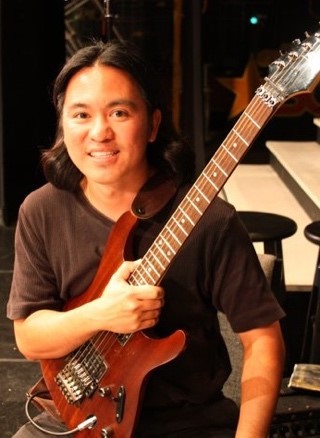 Darin Au has served on the NAfME Council for Guitar Education as the Western Division Representative since 2015. He is a faculty member of the Academy Music Department at Punahou School in Honolulu, Hawaii, where he has taught for more than 20 years. He is active as a performer on guitar, playing classical, rock, and reggae. As a composer, his published work, Chasing Dragons, received its premiere at the Guitar Foundation of America Festival in 2000 and since has had many performances around the world. The NAfME All-National Guitar Ensemble conducted by Dr. Michael Quantz also performed Chasing Dragons in November 2018. His new work for guitar ensemble, Gävlebocken, is slated for a world premiere video performance by the All-National Guitar Ensemble with guest conductor, Chuck Hulihan, at the NAfME National Conference in January 2021. Darin received his Master of Music degree in Composition from the University of North Texas.
Darin Au has served on the NAfME Council for Guitar Education as the Western Division Representative since 2015. He is a faculty member of the Academy Music Department at Punahou School in Honolulu, Hawaii, where he has taught for more than 20 years. He is active as a performer on guitar, playing classical, rock, and reggae. As a composer, his published work, Chasing Dragons, received its premiere at the Guitar Foundation of America Festival in 2000 and since has had many performances around the world. The NAfME All-National Guitar Ensemble conducted by Dr. Michael Quantz also performed Chasing Dragons in November 2018. His new work for guitar ensemble, Gävlebocken, is slated for a world premiere video performance by the All-National Guitar Ensemble with guest conductor, Chuck Hulihan, at the NAfME National Conference in January 2021. Darin received his Master of Music degree in Composition from the University of North Texas.
Interested in reprinting this article? Please review the reprint guidelines.
The National Association for Music Education (NAfME) provides a number of forums for the sharing of information and opinion, including blogs and postings on our website, articles and columns in our magazines and journals, and postings to our Amplify member portal. Unless specifically noted, the views expressed in these media do not necessarily represent the policy or views of the Association, its officers, or its employees.
October 22, 2020. © National Association for Music Education (NAfME.org)
Published Date
October 22, 2020
Category
- Innovation
- Technology
Copyright
October 22, 2020. © National Association for Music Education (NAfME.org)
